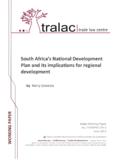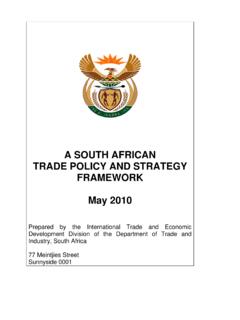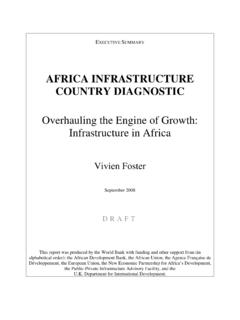Transcription of Egypt’s Industrial Development Strategy Industry: …
1 1 Egypt s Industrial Development Strategy industry : The engine of growth ) ( Forward We live in an ever-changing world, constantly surrounded by overwhelming changes and challenges, a world in which we can no longer go on without having clear answers to critical questions: How do we want our future to be? What do we need to realize it? Indeed, we look forward to a future in which higher income, sufficient employment, and a better global posting are realities. This, however, needs from us to seriously rethink the present. The truth is that our aptitude far exceeds what we ve accomplished so far. This, in turn, should lead us to reconsider our performance, with an aim at faster growth and a better utilization or our real capabilities.
2 To grow, we need a powerful growth driver, and industry , having the strongest forward and backward linkages, and having the greatest potential to grow, will be the overriding engine for growth . But growth , though important, is not our only objective. What we need more is comprehensive Development ; growth with higher welfare for all. Thus, we opt for an industry -led Development pattern; as industry will push the entire economy forward to its full potential. Public policy has a great role to play towards the desired Development , one that far departs from the traditional interventionist policies and is not limited to that of a regulator. It is our duty, as a government, to set up the base for Development , namely Building Domestic Capabilities.
3 Private businesses invest, produce and employ, but it is the government that creates a business friendly environment, supports entrepreneurs, and promotes national skills. Thus it should be prepared to step in whenever needed. In this context, this Strategy puts forth a twenty-year vision for the Egyptian industry that defines strategic targets, and carefully identifies the instruments through which public policy can contribute to Industrial Development . A vision for Egypt to be the leading Industrial power in the Middle East and North Africa by the year 2050. This is an ambitious goal, but one that is certainly attainable. All goals and means are within our reach, and in the end it will all depend on our performance.
4 Implementation is already underway. Many of the designed programs are off the ground, and more will be forthcoming. Implementation is a national task and the Ministry of Trade and industry will not be the sole actor, several public and private partners will be involved. Success will be the result of a concerted Egyptian effort. Our future is now in the making, and we have a long way to go. Yet, with determination, a strong will and enough stamina, our success is only a few steps away. Minister of Trade and industry Eng. Rachid Mohammed Rachid 21. Industrial Take-off: Building on Solid Base Future Industrial policies in Egypt will be focused on enabling the Industrial sector to be the engine of growth through the expansion of exports and job opportunities.
5 At present, the Industrial sector in Egypt is a major contributor to economic growth , employment generation, and export proceeds. Roughly accounting for 20 percent of GDP (excluding informal Industrial activities), there are around 26,000 formally registered Industrial establishments employing nearly million workers and around million workers in informal Industrial establishments which represents around 20% of the labour force. In addition, manufactured exports account for nearly 3% of GDP, 40% non-oil export proceeds and 11% total current account receipts. The Industrial sector is a major growth driver having strong backward and forward linkages with both the agriculture and services sectors.
6 It is expected to play an instrumental role in reinvigorating economic growth in the Egyptian economy over the medium and long terms. Learning from the successful experience of other developing countries, the Industrial sector is bound to become the driver for increasing growth rates, generation of sufficient employment opportunities, and fostering Egypt s integration into the global economy. The Industrial sector is best-positioned as a potential growth driver because: It enjoys strong forward and backward linkages with other important economic sectors such as agriculture and services; It offers high prospects for employment creation especially in labour-intensive industries; It acts as a catalyst for technology transfer and attraction of FDI; and It offers high prospects for deepening Egypt s drive to integrate further into the global economy.
7 Comparative performance indicators suggest that there is a large room for improving the competitiveness of Egypt s Industrial sector. The legacy of state intervention in the Industrial sector coupled with absence of a clear vision and strong commitment to enhancing Industrial competitiveness are seen as primary reasons for the current state of affairs. The time is ripe for envisaging a national Strategy for improving Industrial performance. It has to be emphasized from the outset that implementing the Industrial Development Strategy has to be phased. Three phases are envisaged, each of which leads to, and paves the way for the next. The first phase to be carried out in the short term should have as its objective the increase in exports and employment.
8 In the medium term, the objective will be enhancing Industrial efficiency by building up the necessary institutions for high quality industrialisation. Finally, the building of innovation capacity will be the target for the long term. Parallel to this process is the process of technological advance. Thus, in the short run, the focus will be on leveraging of the existing base of resource-based and low-tech 3industries; and, therefore, on labour-intensive exports. The next stage will witness the upgrading of the technological content of both production and exports by moving to medium-tech industrialization. The highest level, based on high-tech production and exports, will represent the final stage of this process.
9 2. Strategic Vision and Targets: Industrial policies are not limited to sectoral objectives, but represent a consistent set aiming at fostering economic and social Development with industry being the leading sector. The future path for the Egyptian Industrial sector is thus to become the engine of growth , employment creation, and export Development with the objective of deepening Egypt s integration into the global economy as a competitive player. By the year 2025, Egypt will be a leading industrializing nation in the MENA region in terms of Industrial performance as well as a main export hub for medium-technology manufactured products. Vision formulation is an important phase in the process of designing and implementing Industrial Development strategies.
10 The vision for Industrial Development should realistically be based on the country s resource endowment (including human resources) and state of domestic capabilities and facilitating drivers for industrialization such as skills, technological attainment, infrastructure, and level of integration with international markets. Yet, the vision should not be void of ambition. Ambitious industrialization strategies coupled with strong institutional ownership can yield quite successful outcomes. As a relative latecomer, Egypt s potential can be realized through a process of leapfrogging by taking the advantage of accumulated experiences of others.















